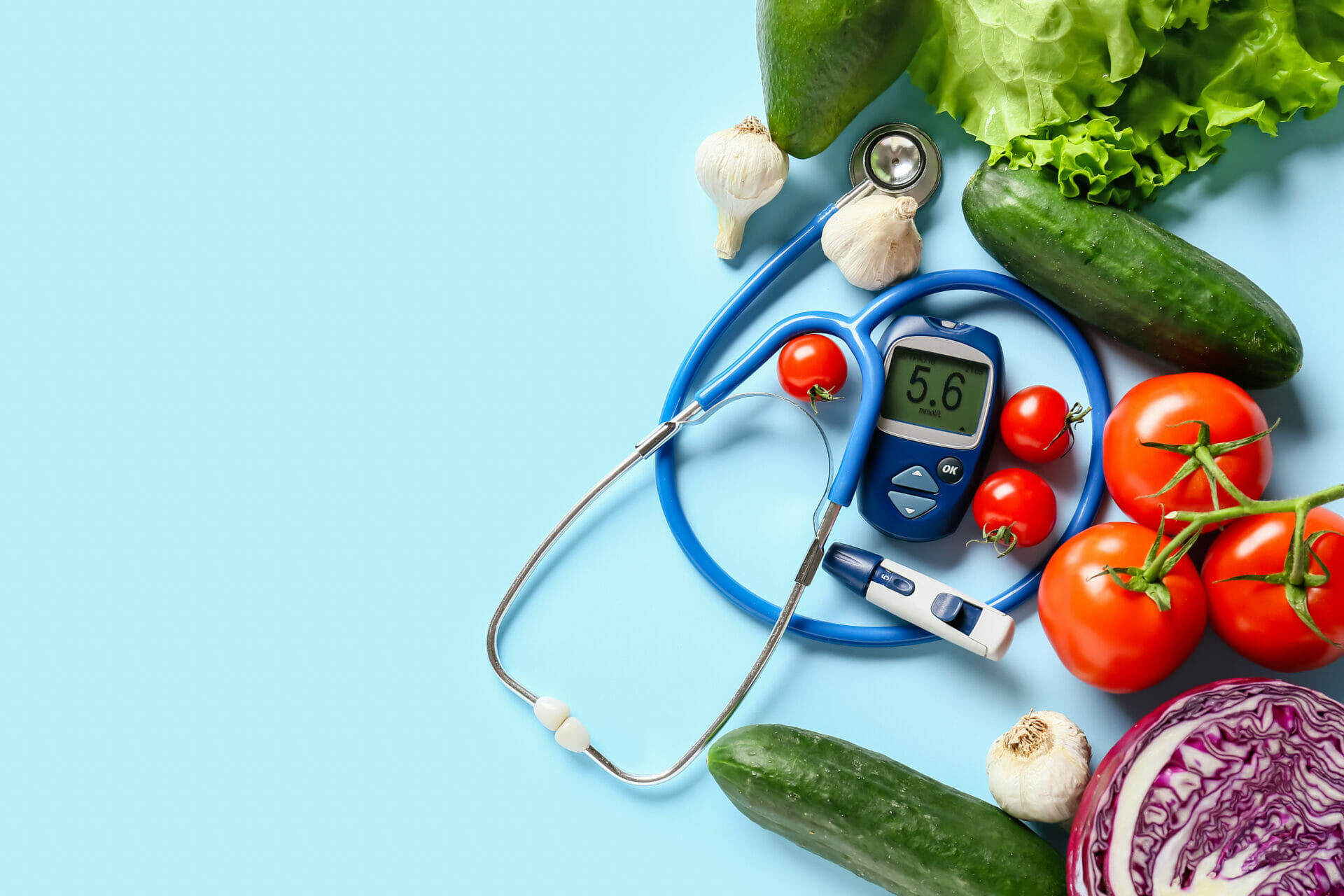Each person with diabetes has a particular form of diabetes, and there is no one-size-fits-all treatment. As a result, there isn’t a ‘diabetic diet’ that works for everyone with the disease. However, we’ve included some advice to assist you in making better eating choices.
A healthy diet can help you control your glucose, blood pressure, and cholesterol levels in general. Diabetes consequences such as heart disease and stroke, as well as other health concerns including some forms of cancer, can be reduced with their assistance.
People with both type 1 and type 2 diabetes have helped us come up with our advice. You may be interested in some of these recommendations if you have a different kind of diabetes, such as gestational, cystic fibrosis-related, or MODY. Diabetics of all kinds should visit a nutritionist for particular counseling.
Eat properly at home if you or someone you know suffers from self-isolation. Additionally, you can learn more about how to eat healthily with diabetes in our interactive Learning Zone, which includes easy and practical food hacks.
What does it mean to you to eat healthfully?
Carb counting is critical if you have type 1 diabetes to maintain stable blood glucose levels. In this step, you figure out how many carbs you’ll eat and how much insulin you’ll require for that meal.
Weight loss is critical for those with type 2 diabetes since it improves diabetic control. You can lower your blood sugar and lessen the risk of additional issues by taking it. Low-carbohydrate, Mediterranean, and very low-calorie diets all have their advantages and disadvantages. We now know that considerable weight reduction can help some persons with type 2 diabetes go into remission after losing a lot of weight.
Make healthy dietary choices while losing, gaining, or maintaining your current weight regardless of whether you have type 1 or type 2 diabetes.
If you are a type 1 or 2 diabetic, portion sizes are critical. It’s a lot easier to calculate nutritional data if you’re counting carbs or trying to lose weight. Portion sizes are individual, so what works for one person might not work for another.
When it comes to your sentiments regarding food and diabetes, we’ve got a lot of material to assist you.
1. Choosing more nutritious carbs.
As a result, it’s critical to understand which meals include carbs and how they impact blood glucose levels. Choose carb-rich meals that are better for you and watch your serving quantities.
The following are some good carbohydrate sources:
Grains such as brown rice and buckwheat. Fruits and vegetables. Pulses. Unsweetened dairy products like yogurt and milk.
Cutting back on items like white bread, white rice, and highly processed cereals is also essential. If you’re unsure, seek foods high in fiber on the labels.
2. Consume less salt in your diet.
High blood pressure can lead to heart disease and stroke if you consume a lot of salt in your diet. And, of course, all of these problems are made more likely by diabetes.
Try to consume no more than six grams of salt every day. Make sure to read food labels before purchasing pre-packaged goods, as many already include salt. You’ll be able to keep track of how much salt you’re consuming if you cook from home. To amp up the flavor, experiment using a variety of herbs and spices in place of salt.
3. Reduce your consumption of red and processed meats.
If you’re trying to consume fewer carbohydrates, you may want to increase the portion size of your meat dishes to compensate. Red and processed meat, such as ham, bacon, sausages, cattle, and lamb should not be consumed in this manner. All of them have been linked to cardiovascular disease and cancer.
Try these instead of red and processed meat:
Pulses, such as beans and lentils, eggs, fish, poultry, such as chicken and turkey, and unsalted almonds are also good options.
Beans, peas, and lentils are also high in fiber and don’t raise your blood sugar levels, making them an excellent substitute for processed and red meat. Salmon and mackerel are magnificent sources of omega-3 fatty acids, which have been shown to have several health benefits. Omega-3 oil, which is abundant in numerous foods, is thought to protect the heart. Two servings of oily fish each week is a good goal to strive for.
4. Eat more vegetables and fruits.
We all know fruits and vegetables are exceptional for us. Eating more during mealtimes and having them as snacks when you’re hungry is always a smart idea. The vitamins, minerals, and fiber you need to stay healthy may be obtained through this method.
You might be thinking of fruit, with all its sugar, as something you should stay away from. No, that’s not correct. It doesn’t matter whether you have diabetes or not; whole fruit is beneficial to everyone. Sugar is present in fruits; however, it is a healthy kind of sugar. Things like chocolate, cookies, and cakes typically include countless added sugars (also known as free sugars).
If you want to avoid additional sugar, opt for whole fruit rather than fruit drinks. There are several ways to obtain this, including fresh, frozen, dried, or canned (in juice, not in syrup). It’s also advisable to spread it out over the day, rather than consuming a large piece all at once.
5. Select fats that are good for you.
It’s important to include fat in our diets since it provides us with the energy we need. Nonetheless, our health is affected by a variety of fat types.

Olive oil, rapeseed oil, and sunflower seed oil are good sources of unsaturated fats. Saturated fats can raise cholesterol levels, putting you at greater risk of heart disease. Red and processed meat, ghee, and butter are all examples of foods high in omega-3 fatty acids.
Biscuits, cakes, pies, and other baked goods are made with lard.
Even if you can’t eliminate your use of oils, you should still strive to do so by cooking your meal on the grill, steaming it, or baking it.
6. Cut back on added sugars
We realize that cutting off sugar might be a challenge at first, so we’ve put together a list of simple, practical replacements that will help you get started. Water, plain milk, or sugar-free tea and coffee might be an excellent place to start instead of sugary beverages.
If you’re looking to reduce your caloric intake, artificial sweeteners (sometimes referred to as low- or zero-calorie sweeteners) are an option. Eliminating these extra sugars will help you better regulate your blood sugar and lose weight. If you get hypoglycemia as a result of your diabetes medication, and you consume sugary drinks to alleviate it, you should not stop doing this. However, if you are frequently experiencing hypoglycemia, you should bring this up with your diabetes care team.
7. Use discretion when selecting snacks.
Instead of potato chips, pretzels, cookies, and chocolate bars, reach for plain yogurt, unsalted almonds, seeds, and fresh fruits and vegetables. However, keep an eye on your portion sizes — this will help you monitor your weight.
8. Moderately consume alcoholic beverages.
If you’re attempting to shed some pounds, but you’re also a heavy drinker, it might be time to reduce your intake. Aim for no more than 14 units each week. To avoid binge-drinking, try to limit yourself to no more than one or two drinks every day.
Drinking on an empty stomach is particularly a bad idea if you’re on insulin or other diabetic treatments. This is because drinking might increase the risk of hypos.
9. So-called diabetic food is pointless, so avoid it.
The phrase “diabetic food” is now a criminal offense in the United States. This is due to the lack of evidence that these foods are superior to a healthy diet. As with other comparable goods, they can raise or lower your blood glucose levels depending on the amount of fat and calories they contain. These meals can also have a laxative impact at times, so be aware of that.
10. Foods are a great source of minerals and vitamins.
Mineral and vitamin supplements have not been shown to aid in the management of diabetes. Supplements are unnecessary in most cases, except in cases when you’ve been advised to take them by your doctor, such as during pregnancy.
It’s best to consume a variety of meals to ensure that you’re getting all the nutrients you need. This is because some supplements, such as those that worsen renal illness or interact negatively with your diabetic meds.
Keep moving at all times.
Getting more exercise and eating well go hand in hand. If you have diabetes, it can help you better control your condition and lower your chance of developing heart disease. Your muscles utilize more glucose, and insulin can work more effectively as a result.

Aim for at least 150 minutes of moderate-intensity physical exercise each week as your minimum goal. You’ve engaged in an activity when your heart rate, breathing rate, and body temperature increase. Talking and being somewhat breathless should be all that’s keeping you from passing out. You also don’t have to complete the 150 minutes in one sitting. Spend 30 minutes five times a week, but break it up into 10-minute pieces.

